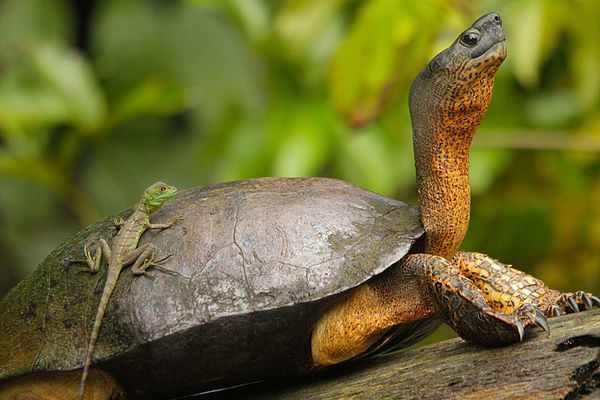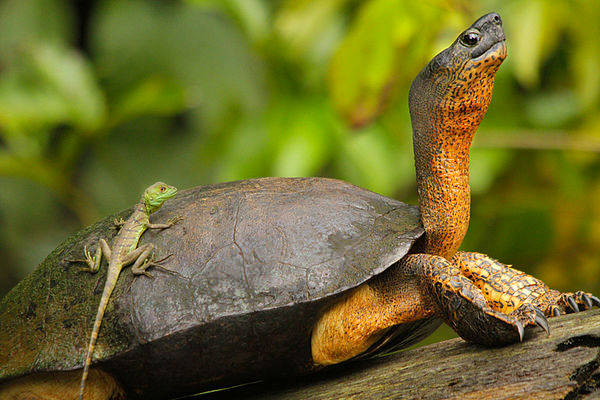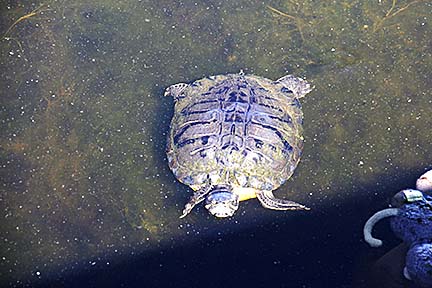How to fix turtle shell glare?
Jun 19, 2016 10:19:19 #
Jun 19, 2016 10:30:50 #
sakitson wrote:
Submission by mubashm reminded me of glare problem I encounter with turtles. On the rare occasion I get close enough to one, does anyone have experience with using an opaque screen to cut the glare and bring out patterning on turtle shells? Or any other ideas? Thanks.
Circular Polarizer
Jun 19, 2016 10:58:07 #
sakitson wrote:
Submission by mubashm reminded me of glare problem I encounter with turtles. On the rare occasion I get close enough to one, does anyone have experience with using an opaque screen to cut the glare and bring out patterning on turtle shells? Or any other ideas? Thanks.
Polarizer.
Jun 19, 2016 12:03:06 #
Jun 19, 2016 12:57:10 #
sakitson wrote:
I can't decide whether this site is more entertainment than photography, but thanks to all for a good time!
How about entertaining photography?
Jun 19, 2016 13:04:42 #
Jun 19, 2016 13:09:13 #
wdross
Loc: Castle Rock, Colorado
sakitson wrote:
Submission by mubashm reminded me of glare problem I encounter with turtles. On the rare occasion I get close enough to one, does anyone have experience with using an opaque screen to cut the glare and bring out patterning on turtle shells? Or any other ideas? Thanks.
Use a polarizer but remember that you want to optimize it (darken) for the light coming off the turtle's shell, not the water or plants that may also be in the picture. The angle for the light coming off the shell may be a different angle than that of the water or plants.
And, yes, UHHs can be as entertaining as it can be informative. Personnally I like the comment about using less Turtle Wax.
Jun 19, 2016 15:31:30 #
Ha, that's good. I do usually look at whole scene for glare not just the shell.
Jun 19, 2016 16:24:39 #
sakitson wrote:
Submission by mubashm reminded me of glare problem I encounter with turtles. On the rare occasion I get close enough to one, does anyone have experience with using an opaque screen to cut the glare and bring out patterning on turtle shells? Or any other ideas? Thanks.
Glare on the turtles shell can easily be controlled by using a reflection blocker. Happy Fathers Day and my best, J. Goffe

Jun 19, 2016 16:36:45 #
SharpShooter wrote:
You could use a flash to balance the light or you ... (show quote)
Turtle Theft. Some places against the law to remove any wild life such as animals, plants etc. So how about taking a portable studio to the turtle. That way the kids can watch mom (or is it dad) as she/he is groomed for their day of fame. Just how do you tell the difference between a male and female turtle? Or is that something I really rather not know.
Jun 19, 2016 16:39:17 #
sakitson wrote:
Ha, that's good. I do usually look at whole scene for glare not just the shell.
Come my way and you will have plenty of turtles to pick from. If the one you want decides to move on then you can pick from the other 50 that are on the logs nearby.
Jun 19, 2016 16:49:41 #
the f/stops here wrote:
Glare on the turtles shell can easily be controlled by using a reflection blocker. Happy Fathers Day and my best, J. Goffe
====================
Did a little "this and that" with CS-5 and NIK Software filters - namely the Polarizer.
Hope that you do not mind... As you did not post a really good copy this is about all that I could do with it.
Overall - I really liked your composition of this photograph.

Jun 19, 2016 16:55:34 #
James R wrote:
====================
Did a little "this and that" with CS-5 and NIK Software filters - namely the Polarizer.
Hope that you do not mind... As you did not post a really good copy this is about all that I could do with it.
Overall - I really liked your composition of this photograph.
Did a little "this and that" with CS-5 and NIK Software filters - namely the Polarizer.
Hope that you do not mind... As you did not post a really good copy this is about all that I could do with it.
Overall - I really liked your composition of this photograph.
James, thanks for the PS touch-up but the point of the image was: blocking the reflection with humor. My image is what I captured and not a manipulated photo. Guess I just wasn't very clear.
Jun 19, 2016 18:02:52 #
I've also had problems with glare when photographing turtles. Using a polarizer gave minium help. The only solution for me was shooting early in the day when the sun is low in the sky.

Jun 19, 2016 18:53:44 #
I'm not a turtle shooter but you likely have a mix of diffuse reflection, direct reflection (mirror-like), and polarized reflection (glare). Approaches to try, including a couple for the light-hearted photographer:
--Do polar filtering of the light source or of the light entering the lens or both ("Light, Science and Magic")
--Put a large diffuser or two between the sun and the turtle, near the turtle
--Use bounce light as key, to diffuse the untoward reflection
--Place the key light so the direct reflection’s angles of reflectance do not return to the camera (Fig. 3.7 of “Light…”) – or wait for the turtle and/or sun to move in a way that satisfies a required angles
--Spray on some diffuser (like Angelus Paint Duller) -- unless your testudine is alive
--Use a larger light source
--Shroud the lens with the manufacturer's hood
--Accept some glare from the carapace as useful information for the viewer
Another possibility, but I am unsure, is to use a longer lens.
--Do polar filtering of the light source or of the light entering the lens or both ("Light, Science and Magic")
--Put a large diffuser or two between the sun and the turtle, near the turtle
--Use bounce light as key, to diffuse the untoward reflection
--Place the key light so the direct reflection’s angles of reflectance do not return to the camera (Fig. 3.7 of “Light…”) – or wait for the turtle and/or sun to move in a way that satisfies a required angles
--Spray on some diffuser (like Angelus Paint Duller) -- unless your testudine is alive
--Use a larger light source
--Shroud the lens with the manufacturer's hood
--Accept some glare from the carapace as useful information for the viewer
Another possibility, but I am unsure, is to use a longer lens.
sakitson wrote:
Submission by mubashm reminded me of glare problem I encounter with turtles. On the rare occasion I get close enough to one, does anyone have experience with using an opaque screen to cut the glare and bring out patterning on turtle shells? Or any other ideas? Thanks.
If you want to reply, then register here. Registration is free and your account is created instantly, so you can post right away.









